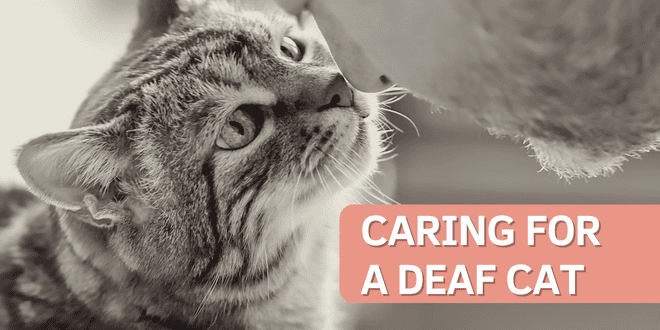
Cats have an incredible sense of hearing. The range is about 45-64000hz, compared with 64-23000hz in humans and 67-45000hz in dogs. They can hear sounds humans can’t and they even win out over dogs when it comes to high frequency hearing. Being both predator as well as prey, a cat relies heavily on their sense of hearing. A cat’s ears are exquisitely designed marvels of efficiency as they can rotate 180 degrees to precisely pinpoint the location of a sound. That being said, a cat with diminished or total hearing loss can enjoy a fulfilling, happy and healthy life if precautions are taken to ensure safety and security, beginning with living exclusively indoors.
What Causes Deafness in Cats?
Just as with humans, cats can develop diminished hearing or lose it completely as they age. Because it can happen so gradually, it may go undetected by the human family for quite a while.
It can be congenital as well so a cat may be born with partial or total deafness. Congenital deafness more commonly occurs in white cats with blue eyes, but it’s a myth that ALL blue-eyed white cats are deaf.
Temporary reduced hearing may be the result of an excessive amount of ear wax. This can be corrected by having the cat’s ears cleaned by the veterinarian.
Deafness may also result from untreated conditions such as ear mites, ear infections, and other health issues. Cancer, tumors, or trauma to the ear may also result in deafness. Hearing loss due to the use of toxic products for ear cleaning or administration of toxic drugs can contribute to hearing loss.
Ear damage from very loud noises can cause hearing loss.
Signs of hearing loss can include:
- Sleeping undisturbed through loud noise
- Difficulty being awakened
- Not responding to being called
- No longer responding to typical household noises
- Startling more easily
- No longer responding to the sound of toys that make noises
- Becoming more isolated
How Can You Tell if Your Cat is Deaf?
It can be hard to tell if he has always been less responsive and less inclined to interact with family. If there are other animals in the home, the deaf cat often learns to watch for visual cues to determine if something is going on, which can also make the hearing loss less noticeable to family.
If your cat startles more easily now, there may be hearing loss or total deafness. The cat may no longer react when you clap your hands nearby or shake something that makes noise, such as a set of keys. If you are testing to determine if your cat has hearing loss, make sure you are out of his line of sight so the reaction isn’t based on the visual cue.
Since cats are so adept at using their other senses, you may not notice hearing loss until it’s in a more advanced stage.
One thing you may become aware of is that the cat begins meowing more loudly because he can’t hear. A deaf cat may pay closer attention to other environmental signals such as air currents when a pet companion or human passes by. Vibrations also become an important warning system as well. The cat may feel the vibration of footsteps as you walk by or the vibration of music or TV being turned on which tells the cat someone has entered the room.
If you suspect hearing loss in your cat, have your veterinarian do an exam.
There is a test for deafness called the BAER (brain stem auditory evoked response) test. It consists of placing three small electrodes subcutaneously (similar to acupuncture needles). In most cases, the animal doesn’t need sedation and the test is very quick. The test is performed at special sites and your veterinarian will have more information on BAER test locations.
How to Communicate with and Train a Deaf Cat
Avoid startling your cat by always coming into his visual field before petting or picking him up.
Greet your cat by coming into his line of sight, getting down on his level and extending your index finger to sniff. This is similar to nose-to-nose sniffing that familiar cat friends do.
You can clicker train a deaf cat as you would a cat with hearing, but instead of using a noise-making clicker, use a penlight. Don’t use a laser pointer, and don’t shine the penlight in the cat’s eyes. Do a quick flash with the penlight and offer a treat. Do this about 10 times to help the cat associate the light with the delivery of the treat. Then, when the cat displays a desired behavior, mark it with the penlight and immediately offer a treat, just as with traditional clicker training.
A deaf cat can feel vibrations so as you come into a room, solid footsteps will help him become aware of your presence.
You can communicate and train your cat using hand signals. Make your signals one-handed and be totally consistent in the presentation as well as what behavior you’re requesting. If there are other family members in the home, teach them the signals as well so the cat will always receive the exact same message. Develop hand signals for at least the most basic commands or situations such as come here. You can combine hand signal training with penlight clicker training. You can also create a meal announcement hand signal so the cat will know when dinner is served if you feed on a schedule.
If there are other cats in the house, the deaf cat will watch and learn many communication signals through them.
Caring for a Deaf Cat
Never let your deaf cat outdoors unless confined in a safe catio enclosure. A deaf cat can never wander outdoors, even if you’re convinced he’ll stay close to home. A deaf cat can’t hear horns honking, barking dogs, the warning sounds of another cat nearby, as well as any other sounds of danger.
Since a deaf cat can’t hear to respond to being called when out of sight in the home, consider attaching a small key finder to his collar for location purposes.
Provide your cat with several perching and napping areas so he can position securely to avoid being startled. It’s common for deaf cats to seek out areas that give them the most visual warning ability.
Playtime with a Deaf Cat
A deaf cat benefits from regular playtime just as any cat. To prevent your deaf cat from isolating himself, incorporate interactive play into the daily schedule. If you have a multicat household, conduct private play sessions with your deaf cat so he doesn’t have to worry about a cat companion suddenly pouncing on the toy and causing a startle response.
Set up plenty of opportunities for solo playtime by placing toys strategically all around the cat’s area. Toys that are perched on the edge of a cat tree shelf or peeking out from underneath furniture can spark curiosity and inspire a little solo play session.
Food-dispensing toys are another great option for any cat, but they can be especially beneficial for your deaf cat to help keep him active and engaged.
Need More Information?
For more information on cat behavior and training, check out the books written by best-selling author Pam Johnson-Bennett. Pam’s books are available at bookstores and online, and through the Amazon links here on our website.
This article is not to replace your cat’s regular veterinary care and isn’t intended as a medical diagnosis. If you have questions about your cat’s health or have questions about hearing loss, contact your veterinarian.



